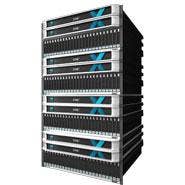EMC Fires Up Flash Storage With XtremIO All-Flash Storage Array

EMC Tuesday advanced its flash storage strategy with the official unveiling of its first all-flash storage array and the introduction of a new line of PCIe Flash storage accelerators.
The storage kingpin also introduced a new software suite it said will manage all flash storage across the data center.
With the new additions to its lineup, EMC now has a very comprehensive flash storage portfolio from the server to the all-flash array, said Zahid Hussain, senior vice president and general manager of EMC's Flash Business Unit.
[Related: NetApp Takes Build-It, Not Buy-It, Approach To FlashRay Flash Storage Strategy ]
"We're committed to an end-to-end approach on how flash is deployed and managed," Hussain said.
EMC's new flash strategy starts in the server with the XtremSF series of PCIe-based flash storage accelerator cards.
The XtremSF cards are available using either SLC-based or eMLC-based technology, Hussain said. The SLC-based XtremSF cards were designed with either 350 GB or 700 GB of memory, while the eMLC-based cards will be available in 550-GB, 700-GB, 1,200-GB and 2,200-GB models.
Hussain compared the XtremSF performance to that of Fusion-io, one of the leaders in this market, saying that the EMC models feature higher performance because they use less of the host server's processing power to handle the flash storage functions.
Both EMC partner Cisco and EMC archrival NetApp partner with Fusion-io for PCIe-based flash storage accelerator technology.
XtremSF is not EMC's first server-based PCIe flash storage offering.
EMC last year unveiled VFCache, which combines EMC's software with PCIe flash storage software with SLC-based hardware from either LSI or Micron. With the introduction of its XtremSF line, EMC will discontinue the use of the VFCache moniker and offer both eMLC and SLC models with the XtremSF logo, Hussain said.
EMC, Hopkinton, Mass., also officially rolled out its first all-flash storage array, which resulted from EMC's 2012 acquisition of Israel-based startup XtremIO.
Josh Goldstein, XtremIO vice president of marketing and product management for EMC's Flash Business Unit, said the new all-flash storage array is now in directed availability, meaning that it can be sold to customers with certain use cases, and that it is expected to be in general availability in the second half of 2013.
NEXT: New XtremIO All-Flash Storage Array
XtremIO is at its heart based on proprietary software running on industry-standard server and SSDs, Goldstein said. Each 4U XtremIO storage block, which EMC calls an X-Brick, has a capacity of 6.763 TB without deduplication, and offers more than 150,000 functional 4-KB mixed read-write IOs per second and 250,000 functional 4-KB read IOPS.
The array features scale-out operation so that adding a new X-Brick scales both capacity and performance linearly. "If you add an X-Brick to the original X-Brick, you double performance and capacity," he said. "Add two more, and they double again."
XtremIO also utilizes all the flash storage components and other components across the system to increase performance, Goldstein said.
"In a lot of flash array systems, you have to designate volumes to live on certain drives," he said. "We distribute the volumes across all the drives and controllers to get the best performance. Because performance is inherently consistent, you get the best performance. And services like thin volumes, inline dedupe and snapshots can be done all at full performance."
EMC also wants to tie server-based PCIe flash storage to its new XtremSW Suite. The XtremSW Suite builds on the company's XtremSW Cache software, which turns server-based flash into a high-performance cache.
The XtremSW Suite, when it ships in mid-2013, will allow eMLC and SLC XtremSF flash accelerators as well as non-EMC PCIe flash devices to be combined into a larger cache or as a high-performance direct-attached storage pool with coherency for Oracle RAQ and Microsoft clusters, Hussain said.
"It's the software layer that will drive customer adoption of PCIe flash storage," he said.
EMC's flash storage strategy is based on some powerful technology, said Jamie Shepard, regional vice president at Lumenate, a Dallas-based solution provider and longtime EMC partner.
Shepard's former company, ICI, which in January merged with Lumenate, had one of EMC's first VFCache accelerators and a pre-acquisition XtremIO flash storage array in its labs tied together as part of a virtual desktop infrastructure solution. "It was ridiculously faster than anything we tested before," he said.
The new XtremSF accelerators and XtremIO arrays are not dumb flash storage products, but instead feature a lot of intelligence that Fusion-io and others will have to integrate to compete, Shepard said.
NEXT: EMC 'Very Smart' About Its Flash Business, VAR Says
"EMC is coming out of the gate with full integration of flash with their software," Shepard said. "EMC [is doing] it the right way, even if they lose a bit of time doing it."
EMC was also very smart in that its Flash Business Unit, which was previously headed by former Intel executive and now VMware CEO Pat Gelsinger, was set up so that it does not report to the company's storage business, Shepard said.
EMC has SSDs as cache in its storage arrays, as well as FAST Cache software for tiering and virtual provisioning, he said. "But its server-based flash focus is separate," he said. "That's important. It's perfect, actually. It's EMC being smart. If they want to compete with Fusion-io, Whiptail or other startups, its server flash business shouldn't be part of storage."
PUBLISHED MARCH 5, 2013